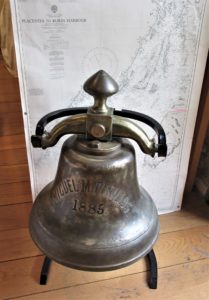Tucked away in a side street we came across what appeared to be an interesting nautical museum. It is located in the Old Town of Plentzia, 25 km north east of Bilbao. The museum, formerly a Town Hall, was built in the 16th century. In January 1999, the Placentia de Butrón Foundation inaugurated the museum. It’s vision was to recover and exhibit different elements of the history of Plentzia, closely related to the sea. On the outside of the museum it shows two shields,one of the town and the other, that of the Catholic Monarch
As we walked inside it seemed like an aladdin’s cave of maritime treasures. Not only that, but we discovered that admission was free!
The permanent exhibition, shows models of boats through the evolution of navigation. The oldest model to catch my eye, was a galleon – amazing! Not only was it used for cargo but was also a war vessel. Vessels depicting the 18th century included the frigate, the brig and the schooner.
Clipper boats were on show representing the late 19th century as well as steam boats which became popular. Merchant vessels, large crude oil tankers and passenger ferries came along with the 20th century. Quite few paintings could be seen, some of which were painted by crew members.
We climbed the stairs to a second floor where photographs of sailors were displayed.
Also, there is a display of different navigational instruments. Some,used for navigation and observation of the stars, such as: sextants, binoculars, octants, planispheres. There was a log book, compass, and other items for measuring speed. Items taken from boats were bells, a rudder and lamps and even a dinner service. A display of regulations, maritime documentation and charts, diaries ships’ photographs – and so the list goes on!
The temporary exhibition of 2019 is ‘.Shipwrecks in the Bay of Biscay.’ There are maps of the wrecks and showcases containing objects relating to the sea rescue. Biscay is home to fiercely bad storms in winter months making you realize just how countless shipwrecks have taken place over the years.The Bay of Biscay has always been feared by seamen.
Dating back to the second World War, German U-boats ruled the Bay and many British and American ships were reported sunk that entered her waters. There were as many as 15,000 casualties and another 5,000 ships that sunk. Despite the danger to the ships, they had no choice but to take the route to take troops and supplies to France.
The sea may look beautiful on a calm sunny day, but this exhibition brings home the dangers, difficulties and sometimes, grave consequences on this notorious body of water.
We spent some time in the museum as there was so much to see and take in. Something here for people of all walks of life, even children were fascinated to see the models of ships.
Opening times are – mornings: 11:00 – 14:00 from Wednesdays to Saturdays between 1st Oct and 31st May/10 and from Thursdays to Sundays between 1st June and 30th September. Afternoons: 17:00 – 20:00 (Fridays and Saturdays)








